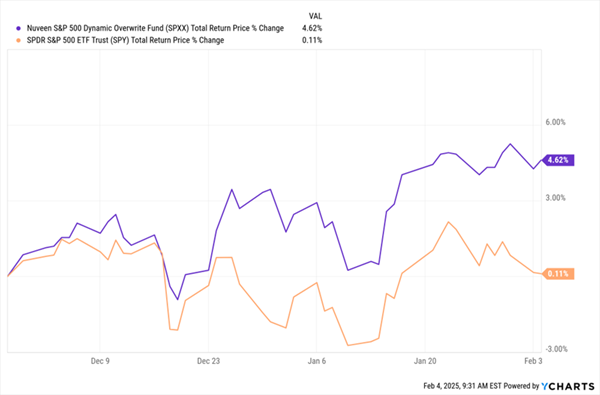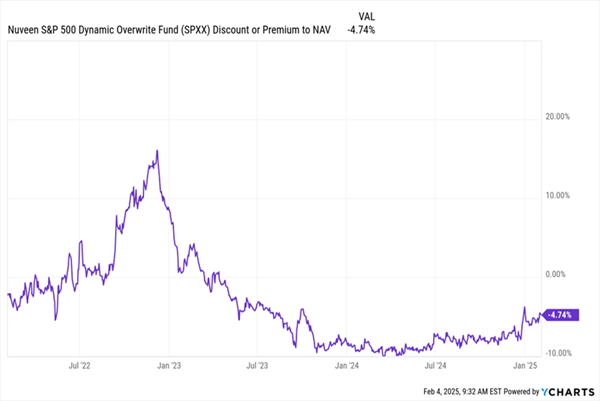This 7.6% Dividend Plays Offense and Defense in a Trade War
Trade tensions ratcheted up to 11 this week, and I know that for many readers the wild swings we’re seeing can feel sickening.
A 7.6% Dividend Built for Tariff-Wary Times
That’s a key advantage of all CEFs. And perhaps the coolest thing here is that we have CEFs that are purpose-built for times like these, like the Nuveen S&P 500 Dynamic Overwrite Fund (NYSE:)—current yield 7.6%.
That’s because SPXX “goes on offense” in the form of exposure to stocks like Microsoft (NASDAQ:), American Express (NYSE:) and Pfizer (NYSE:). At the same time, it plays “defense” with a strategy that creates more income when volatility ticks up.
That strategy is the fund’s sales of covered-call options. These offer investors the right to buy SPXX’s stocks at a fixed time in the future, at a fixed price. If the stock fails to hit that price (more likely in a correction), nothing happens, and SPXX keeps the fee it charges for the option, fueling its 7.6% payout.
Here’s how recent trade drama sets the table for SPXX and CEFs like it.
Trade Shifts Cause Investor Whiplash
No matter what ultimately happens, in terms of the length or level of tariffs ultimately imposed (and on whom), the question is to what extent they’d change the flow of funds between manufacturers, importers, retailers and consumers. More importantly, we want to know whether those changes would result in less consumption and, as a result, economic troubles.
For Canada, tariffs would almost certainly mean a recession, since 77% of Canada’s exports go to the US. The situation is similar in Mexico. About 78% of that country’s exports go to the US, with the automotive, agricultural and energy sectors most likely to get hit.
This, in turn, could cause prices for food from Mexico and energy from Canada to rise. This also explains why the US, Canada, and Mexico reached a deal to pause these tariffs for a month, which means investors don’t have to worry about the impacts of a potential trade war for now.
But a month isn’t a particularly long time, and we can expect other factors influencing trade and prices to become more significant. Expect more discussion about other factors driving the price movements of food and energy that could offset the tariffs, such as the fact that Canada has boosted energy production, including 7% year-over-year increases in output, according to the Canadian government.
Creating a Perfect Setup for SPXX and Other Covered-Call Funds
All of this leaves “first-level” investors—by those I mean the ones who stick mainly to the big-cap S&P 500 names—struggling to figure out if Trump’s tariffs will damage company valuations or not.
One thing that’s for sure (as we CEF investors know well) is that given that the worst-case scenario is for higher inflation, selling stocks and going to cash (which loses value faster as inflation rises) makes no sense.
Further, a US recession is unlikely, as early indicators of over 3% GDP growth suggest the economy is firing on all cylinders. Even in a scenario where China, Canada and Mexico were to retaliate in full, America just doesn’t export enough for that to hit the entire economy all at the same time.
A jittery stock market underpinned by a still-strong economy is perfect for SPXX and other covered-call CEFs. That fact is starting to catch more investors’ attention. Consider that since I wrote about SPXX here on Contrarian Outlook in late November, it has returned about 5%, as of this writing, while the S&P 500 has been flat:
SPXX’s Covered-Call Strategy Pushes It Higher in the Early Days of Trump 2.0

Market volatility has been driving SPXX’s performance, and the attention that’s been attracting has shrunk its discount to net asset value (NAV, or the value of the stocks it holds) to 4.7%:
SPXX: On Sale (for Now)

Note that SPXX’s discount hasn’t flipped to the big premium it saw in 2022 when investors were hunting for pretty well anything that could give them a volatility hedge. And if fears keep growing—on tariffs or whatever else—expect SPXX’s discount to flip to a premium (taking its market price with it).
Meantime, buying SPXX now means collecting its 7.6% dividend while we wait for that to happen.
Disclosure: Brett Owens and Michael Foster are contrarian income investors who look for undervalued stocks/funds across the U.S. markets. Click here to learn how to profit from their strategies in the latest report, “7 Great Dividend Growth Stocks for a Secure Retirement.”
#Dividend #Plays #Offense #Defense #Trade #War


